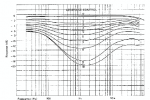restorer-john
Grand Contributor
If memory serves, Yamaha-style loudness has always been sort of backwards from other common implementations - you'd be leaving the main volume constant, adjusting the loudness knob instead. The upside is that you can easily accommodate differing source levels and speaker sensitivity.
It's one of the absolute best loudness compensation functions out there.
That being said, their earlier 1970s implementations were much better than their current ones. This is an actual AS-300/301 loudness plot, with equal step rotation back from 'flat'. Note vertical in Volts. Disappointing Yamaha.
1970s CR-820 loudness:





